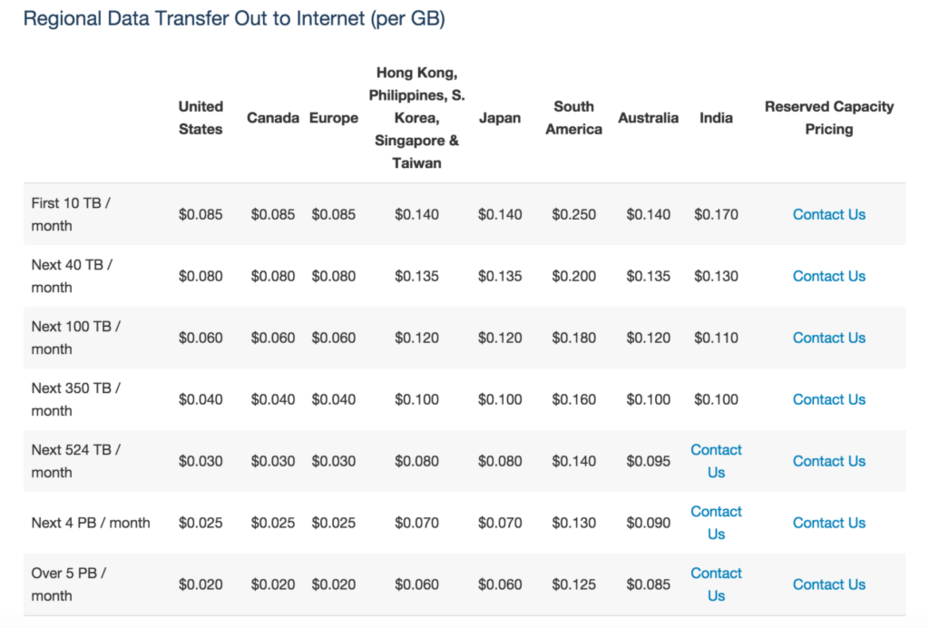Networking, Analytics, Database, Security and Identity, Application services, etc.
We will, however, be concentrating primarily on their CDN in this Cloudfront analysis. This will include an overview of their existing PoP network, the features they sell, and pricing. Cloudfront currently has 41 Presence Points and a total of 63 edge servers, with most of their edge servers located in North America (US), the EU, and Asia. The table below is a list of server locations Cloudfront uses within these 3 continents.
Cloud Infrastructure
That, in effect, gives the content a much bigger power spread and more resources to draw from, which means your end users can pull up the various pages on your website quicker. Additionally, the cloud-based delivery system allows for the distribution of the content as needed.
Functionality
That simply means the service can be used to distribute website content (both static and dynamic), web applications, as well as audio, video, media files, and documents. So you can add the advantages of these services to your website and thus give it a competitive advantage over other similar sites to yours.
AWS Management Console
This includes wizards and workflows to build your own solutions, track your monthly service-by-service expenses, manage security features, and set up new IAM users. For most users, the console is simple and intuitive and provides a search feature so you can find what you need easily.
Advanced Security
The Standard Shield is appropriate for most sites but those with large or sensitive data sets can opt to use AWS Shield Advanced. They also offer AWS Web Application Firewall, which helps prevent common threats to your web apps. You can monitor traffic quickly, and even deploy custom rules to block different patterns of attack. AWS WAF is completely adjustable and you pay for only what you’re using.
How Does CloudFront CDN Increase Website Speed?
CloudFront Pricing
The pricing model for Cloudfront is Pay as You Go. And there are no annual payments and there is no minimum fee. They also have a free tier that offers 50 GB of data transfer out to users and 2 million HTTP and HTTPS requests per month for one year. When the one year mark is up, you’ll be forced to start charging for the traffic you ‘re using. The following tables outline the cost of pricing on each segment.
2. Data transfer out to origin
The next portion of the pricing is focused on how data is transmitted back to the origin server from the Cloudfront edge servers. That includes HTTP requests for DELETE, Choices, Fix, Update, and PUT. The cost fluctuates according to where the visitor is located but there is no volume price.
3. HTTP requests (per 10,000)
Finally, Cloudfront even charges, depending on how many requests are made for HTTP. The following prices are based on a request base per 10,000. The cost fluctuates depending on the location of the user, as well as whether the requests are made over HTTP vs HTTPS.
Why does site speed be important?
One of the key benefits of using CloudFront is that it helps to increase the speed at which the site is paying. But is this really relevant, exactly? As it turns out, indeed. An increase in site load time results in a higher bounce rate, meaning the longer it takes for your site to load, the more users will give up and go back to the search results to find a new site. Research shows you can raise sales by shaving milliseconds off your load-time. In addition to how website speed affects users, websites such as Google and Facebook look at how quickly the website loads to decide how much users are expected to view their content, which means that fast load times are good for SEO. Google PageSpeed Insights is a valuable resource to find out where the website stands.
How to SPEED up my site with CloudFront?
CloudFront is a network of CDN or Content Distribution. They work by saving the website data to various geographical locations in a network of caches. When a user visits your site, the cache which is nearest to them will deliver your web data, resulting in faster delivery.
Will CloudFront be implemented as other amazon Web services/products?
What is the Cost of CloudFront?
CloudFront Reviews– In Conclusion
Although their pricing model is Pay as You Go, be aware that they are paying in three different ways: Internet data, Origin data, and requests for HTTP. Bandwidth costs often increase dramatically depending on where the visitors come from (e.g. priced at $0.25 per GB for South America). Therefore it is important to understand the global distribution of your current website users as well as your CDN budget when looking at Cloudfront as a CDN provider.


